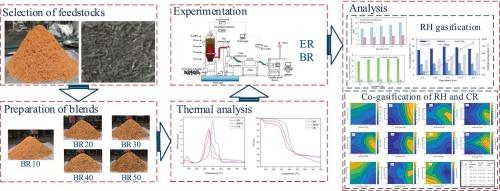稻壳和废橡胶屑在半工业气化炉中的共气化:对增强性能和操作稳定性的实验见解。
IF 7.1
2区 环境科学与生态学
Q1 ENGINEERING, ENVIRONMENTAL
引用次数: 0
摘要
通过气化等更有效的技术转化密度较低的生物质所面临的挑战,使这种燃料不适合用于电力和热力发电部门。本研究旨在通过在半工业气化炉中添加被称为橡胶屑(CR)的废弃轮胎橡胶废料来增强低密度稻壳(RH)的气化,并通过原料消耗、炭生成、合成气浓度、气体热值(CV)、合成气产量和热气效率的变化以及实际挑战来研究其性能。混合原料的热重分析表明,热降解率发生了正变化,这证实了气化效率提高的潜力。在各种混合原料组合中,BR40在0.3 ER时表现出较好的气化性能。即使使用空气作为气化介质,该气化炉也能够产生CV为7.29 MJ/m3的气体,并实现80.14%的热气效率。最佳产气(PG)组成为23.94 vol% CO, 19.08 vol% H2和4.64 vol% CH4,其中H2比单独RH增加57.3%。通过将CR与RH相结合,降低了操作挑战的风险,并且气化过程平稳稳定,没有任何堵塞。因此,希望将CR与密度较低的生物质(包括锯末、椰子髓、花生壳、玉米秸秆等草本生物质)结合使用,以提高其气化性能。本文章由计算机程序翻译,如有差异,请以英文原文为准。

Co-gasification of rice husk and waste crumb rubber in a semi-industrial gasifier: Experimental insights into enhanced performance and operational stability
The challenges in converting less dense biomass through more efficient technologies, such as gasification, have made such fuels unsuitable for the power and thermal generation sectors. This work aims to enhance the gasification of less dense rice husk (RH) by adding discarded tire rubber waste material called as crumb rubber (CR) in a semi-industrial gasifier, and its performance has been investigated through the variation in feedstock consumption, char generation, syngas concentration, gas calorific value (CV), syngas yield, and hot gas efficiency, along with the practical challenges. The thermogravimetric analyses of the blended feedstock showed a positive shift in the thermal degradation rate, which confirms the potential for the enhancement of gasification efficiency. Among the various blended feedstock compositions, BR40 has demonstrated better gasification performance at 0.3 ER. The gasifier is capable of producing gas with a CV of 7.29 MJ/m3 and achieving 80.14 % hot gas efficiency, even when using air as gasifying medium. The optimal producer gas (PG) compositions are 23.94 vol% CO, 19.08 vol% H2, and 4.64 vol% CH4, with H2 evidencing a 57.3 % increase in comparison to RH alone. By combining CR with RH, the risk of operational challenges has been mitigated, and the gasification process has been achieved in a smooth and stable manner, without any clogging. Therefore, it is desirable to combine CR with less dense biomass in order to improve its gasification performance, including sawdust, coir pith, peanut shell, corn stover, and other herbaceous biomasses.
求助全文
通过发布文献求助,成功后即可免费获取论文全文。
去求助
来源期刊

Waste management
环境科学-工程:环境
CiteScore
15.60
自引率
6.20%
发文量
492
审稿时长
39 days
期刊介绍:
Waste Management is devoted to the presentation and discussion of information on solid wastes,it covers the entire lifecycle of solid. wastes.
Scope:
Addresses solid wastes in both industrialized and economically developing countries
Covers various types of solid wastes, including:
Municipal (e.g., residential, institutional, commercial, light industrial)
Agricultural
Special (e.g., C and D, healthcare, household hazardous wastes, sewage sludge)
 求助内容:
求助内容: 应助结果提醒方式:
应助结果提醒方式:


